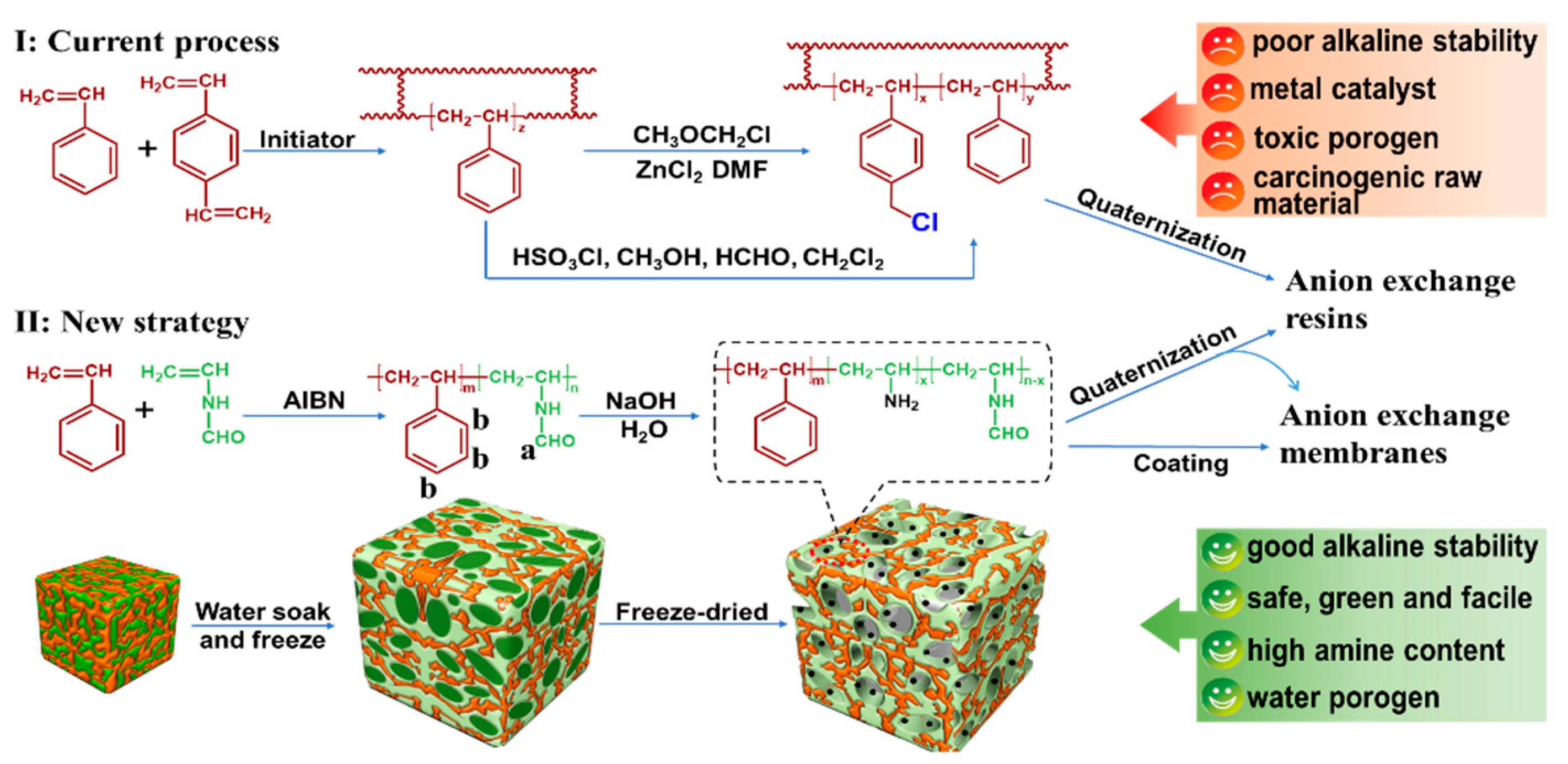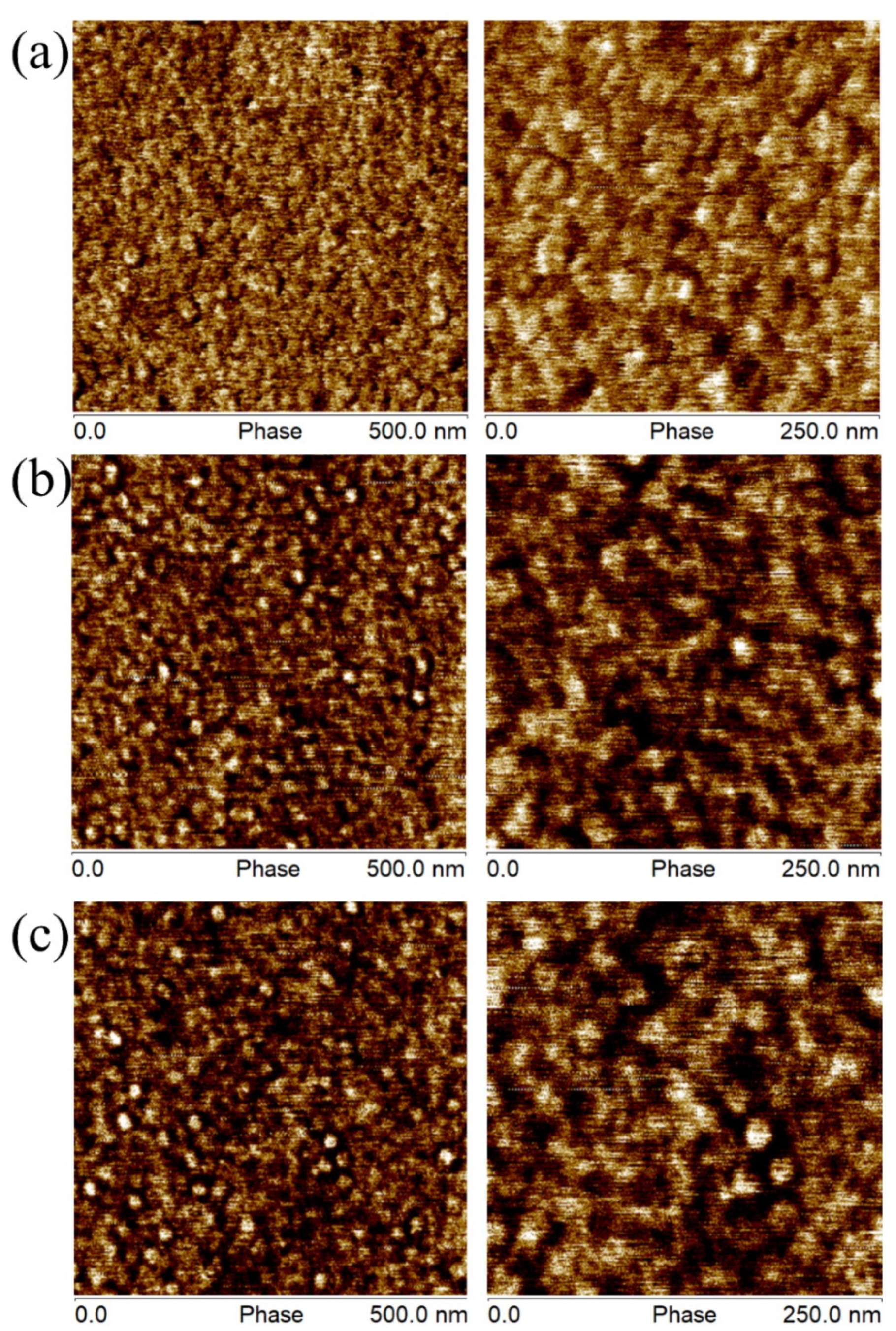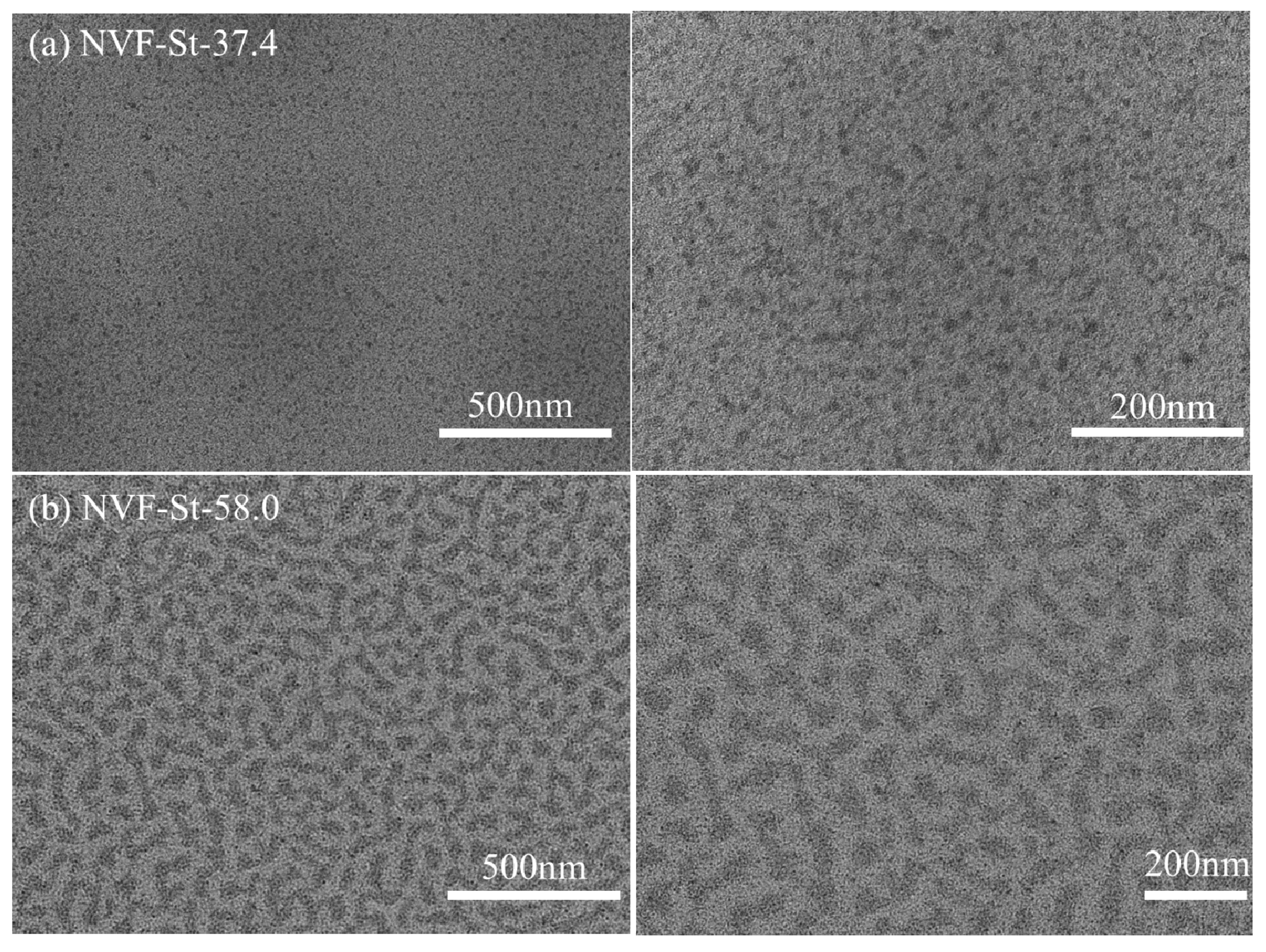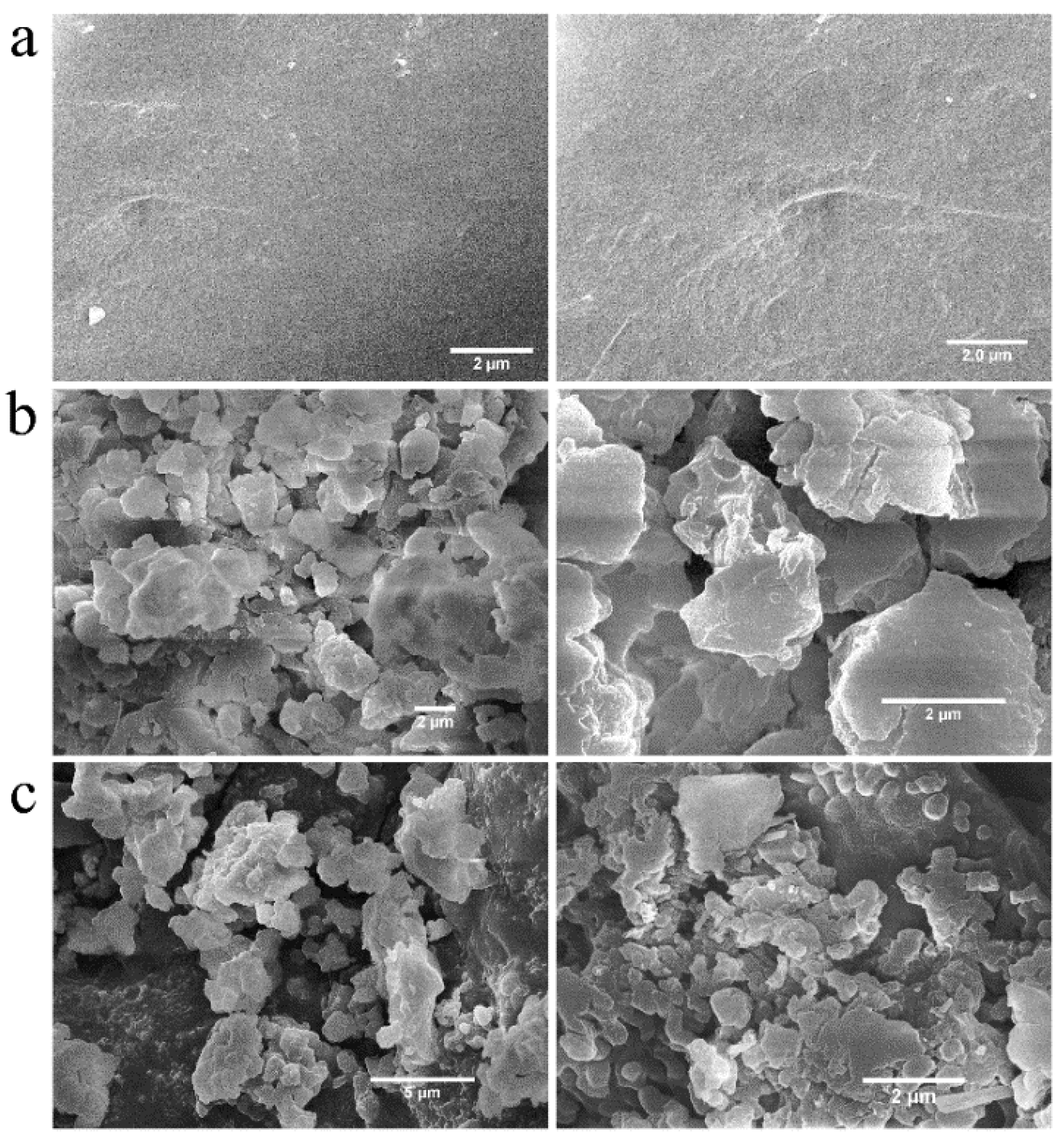Facile and Safe Synthesis of Novel Self-Pored Amine-Functionalized Polystyrene with Nanoscale Bicontinuous Morphology
Abstract
:1. Introduction
2. Results and Discussion
2.1. Structure and Composition of the NVF-St Copolymer
2.2. Microphase Separation Morphology of the NVF-St Copolymer
2.3. Hydrolysis, Quaternization, and Potential Applications of the NVF-St Copolymer
3. Materials and Methods
3.1. Materials and Instrumentations
3.2. Experimental Procedure
3.2.1. Copolymerization of NVF and St
3.2.2. Hydrolysis of the NVF-St Copolymer
3.2.3. Quaternization of the Hydrolyzed Copolymer
3.2.4. Batch Adsorption Experiments
4. Conclusions
Supplementary Materials
Author Contributions
Funding
Acknowledgments
Conflicts of Interest
References
- Bui, T.H.; Hong, S.P.; Yoon, J. Development of nanoscale zirconium molybdate embedded anion exchange resin for selective removal of phosphate. Water Res. 2018, 134, 22–31. [Google Scholar] [CrossRef] [PubMed]
- Mondal, S.; Majumder, S.K. Fabrication of the polysulfone-based composite ultrafiltration membranes for the adsorptive removal of heavy metal ions from their contaminated aqueous solutions. Chem. Eng. J. 2020, 401, 126036. [Google Scholar] [CrossRef]
- Landry, K.A.; Sun, P.; Huang, C.-H.; Boyer, T.H. Ion-exchange selectivity of diclofenac, ibuprofen, ketoprofen, and naproxen in ureolyzed human urine. Water Res. 2015, 68, 510–521. [Google Scholar] [CrossRef] [PubMed]
- Zeppilli, M.; Lai, A.; Villano, M.; Majone, M. Anion vs. cation exchange membrane strongly affect mechanisms and yield of CO2 fixation in a microbial electrolysis cell. Chem. Eng. J. 2016, 304, 10–19. [Google Scholar] [CrossRef]
- Hernández-Fernández, F.; Ríos, A.P.D.L.; Mateo-Ramírez, F.; Godínez, C.; Lozano-Blanco, L.; Moreno, J.I.; Tomás-Alonso, F. New application of supported ionic liquids membranes as proton exchange membranes in microbial fuel cell for waste water treatment. Chem. Eng. J. 2015, 279, 115–119. [Google Scholar] [CrossRef]
- Liu, D.; Xu, M.; Fang, M.; Chen, J.; Wang, L. Branched comb-shaped poly(arylene ether sulfone)s containing flexible alkyl imidazolium side chains as anion exchange membranes. J. Mater. Chem. A 2018, 6, 10879–10890. [Google Scholar] [CrossRef]
- You, W.; Noonan, K.J.; Coates, G.W. Alkaline-stable anion exchange membranes: A review of synthetic approaches. Prog. Polym. Sci. 2020, 100, 101177. [Google Scholar] [CrossRef]
- Fang, M.; Liu, D.; Neelakandan, S.; Xu, M.; Liu, D.; Wang, L. Side-chain effects on the properties of highly branched imidazolium-functionalized copolymer anion exchange membranes. Appl. Surf. Sci. 2019, 493, 1306–1316. [Google Scholar] [CrossRef]
- Merle, G.G.; Wessling, M.M.; Nijmeijer, D.C. Anion exchange membranes for alkaline fuel cells: A review. J. Membr. Sci. 2011, 377, 1–35. [Google Scholar] [CrossRef]
- Yang, K.; Xu, J.; Shui, T.; Zhang, Z.; Wang, H.; Liu, Q.; Chen, W.; Shen, H.; Zhang, H.; Yang, D.; et al. Cross-linked poly (aryl ether ketone) anion exchange membrane with high ion conductivity by two different functional imidazole side chain. React. Funct. Polym. 2020, 151, 104551. [Google Scholar] [CrossRef]
- Seliman, A.F.; Samadi, A.; Husson, S.M.; Borai, E.H.; DeVol, T.A. Preparation of polymer-coated, scintillating ion-exchange resins for monitoring of 99 Tc in groundwater. Anal. Chem. 2011, 83, 4759–4766. [Google Scholar] [CrossRef]
- Yao, P.; Huang, Z.; Zhu, Q.; Zhu, Z.; Wang, L.; Zhu, Y. A novel composite stationary phase composed of polystyrene/divinybenzene beads and quaternized nanodiamond for anion exchange chromatography. Chin. Chem. Lett. 2019, 30, 465–469. [Google Scholar] [CrossRef]
- Cyganowski, P.; Cierlik, A.; Leśniewicz, A.; Pohl, P.; Jermakowicz-Bartkowiak, D. Separation of Re(VII) from Mo(VI) by anion exchange resins synthesized using microwave heat. Hydrometallurgy 2019, 185, 12–22. [Google Scholar] [CrossRef]
- Fu, Y.; Huang, X.; Zhong, S.; Yi, W.-J.; Li, L.-J. A new chloromethylation method based on polystyrene–divinylbenzene. Chem. Pap. 2019, 73, 2183–2188. [Google Scholar] [CrossRef]
- Park, E.J.; Kim, Y.S. Quaternized aryl ether-free polyaromatics for alkaline membrane fuel cells: Synthesis, properties, and performance—a topical review. J. Mater. Chem. A 2018, 6, 15456–15477. [Google Scholar] [CrossRef]
- Pinschmidt, R.K. Polyvinylamine at last. J. Polym. Sci. Part A Polym. Chem. 2010, 48, 2257–2283. [Google Scholar] [CrossRef]
- Pelton, R. Polyvinylamine: A Tool for Engineering Interfaces. Langmuir 2014, 30, 15373–15382. [Google Scholar] [CrossRef]
- Shi, L.; Berkland, C. pH-triggered dispersion of nanoparticle clusters. Adv. Mater. 2006, 18, 2315–2319. [Google Scholar] [CrossRef]
- Marhefka, J.N.; Marascalco, P.J.; Chapman, T.M.; Russell, A.; Kameneva, M.V. Poly(N-vinylformamide)A Drag-Reducing Polymer for Biomedical Applications. Biomacromolecules 2006, 7, 1597–1603. [Google Scholar] [CrossRef]
- Gu, L.; Zhu, S.; Hrymak, A.N.; Pelton, R.H. Kinetics and modeling of free radical polymerization of N-vinylformamide. Polymer 2001, 42, 3077–3086. [Google Scholar] [CrossRef]
- Chang, Y.; McCormick, C.L. Water-soluble copolymers. 47. Copolymerization of maleic anhydride and N-vinylformamide. Macromolecules 1993, 26, 4814–4817. [Google Scholar] [CrossRef]
- Santuryan, Y.G.; Malakhova, I.I.; Gorshkov, N.I.; Krasikov, V.D.; Panarin, E.F. Water-soluble poly(n-vinylamides)as a basis for the synthesis of polymeric carriers of biologically active compounds. Int. J. Polym. Anal. Charact. 2019, 24, 105–113. [Google Scholar] [CrossRef]
- Gu, L.; Zhu, S.; Hrymak, A.N. Modeling molecular weight distribution of comb-branched graft copolymers. J Polym. Sci. Part B Polym. Phys. 1998, 36, 705–714. [Google Scholar] [CrossRef]
- Shevchenko, N.; Pankova, G.A.; Evseeva, T.G.; Shabsel’S, B.M.; Baigil’Din, V.A.; Men’Shikova, A.Y. Copolymerization of styrene with N-vinylformamide and ethylene glycol dimethacrylate and characteristics of the formed particles. Polym. Sci. Ser. B 2014, 56, 132–138. [Google Scholar] [CrossRef]
- Menshikova, A.; Evseeva, T.; Shevchenko, N.; Shabsels, B.; Yakimansky, A.V.; Ivanchev, S.S. Monodisperse Particles Based on Copolymers of Methyl methacrylate or Styrene with N-Vinylformamide. Macromol. Symp. 2009, 281, 61–68. [Google Scholar] [CrossRef]
- Xu, J.; Timmons, A.B.; Pelton, R. N -Vinylformamide as a route to amine-containing latexes and microgels. Colloid Polym. Sci. 2004, 282, 256–263. [Google Scholar] [CrossRef]
- Jeon, C.; Kim, D.W.; Chang, S.; Kim, J.G.; Seo, M. Synthesis of Polypropylene via Catalytic Deoxygenation of Poly(methyl acrylate). ACS Macro Lett. 2019, 8, 1172–1178. [Google Scholar] [CrossRef]
- Alikhani, M.; Moghbeli, M. Ion-exchange polyHIPE type membrane for removing nitrate ions: Preparation, characterization, kinetics and adsorption studies. Chem. Eng. J. 2014, 239, 93–104. [Google Scholar] [CrossRef]
- Zhang, L.; Li, L.; Wang, L.; Nie, J.; Ma, G. Multilayer electrospun nanofibrous membranes with antibacterial property for air filtration. Appl. Surf. Sci. 2020, 515, 145962. [Google Scholar] [CrossRef]
- Chakraborty, S.; Ramakrishnan, S. Surface-Functionalized Polystyrene Latexes Using Itaconate-Based Surfmers. Langmuir 2018, 34, 11729–11737. [Google Scholar] [CrossRef]
- Yang, L.; Ma, H.; Han, L.; Hao, X.; Liu, P.; Shen, H.; Li, Y. Synthesis of a sequence-controlled in-chain alkynyl/tertiary amino dual-functionalized terpolymervia living anionic polymerization. Polym. Chem. 2018, 9, 108–120. [Google Scholar] [CrossRef]
- Brostow, W.; Chiu, R.; Kalogeras, I.M.; Vassilikou-Dova, A. Prediction of glass transition temperatures: Binary blends and copolymers. Mater. Lett. 2008, 62, 3152–3155. [Google Scholar] [CrossRef]
- Park, C.H.; Kim, J.H.; Ree, M.; Sohn, B.; Jung, J.C.; Zin, W. Thickness and composition dependence of the glass transition temperature in thin random copolymer films. Polymer 2004, 45, 4507–4513. [Google Scholar] [CrossRef]
- Yamamoto, K.; Ito, E.; Fukaya, S.; Takagi, H. Phase-separated conetwork structure induced by radical copolymerization of poly(dimethylsiloxane)-α,ω-diacrylate and N,N-dimethylacrylamide. Macromolecules 2009, 42, 9561–9567. [Google Scholar] [CrossRef]
- Nofar, M.; Maani, A.; Sojoudi, H.; Heuzey, M.; Carreau, P.J. Interfacial and rheological properties of PLA/PBAT and PLA/PBSA blends and their morphological stability under shear flow. J. Rheol. 2015, 59, 317–333. [Google Scholar] [CrossRef]
- Ren, D.; Tu, Z.; Yu, C.; Shi, H.; Jiang, T.; Yang, Y.; Shi, D.; Yin, J.; Mai, Y.-W.; Li, R.K. Effect of Dual Reactive Compatibilizers on the Formation of Co-Continuous Morphology of Low Density Polyethylene/Polyamide 6 Blends with Low Polyamide 6 Content. Ind. Eng. Chem. Res. 2016, 55, 4515–4525. [Google Scholar] [CrossRef]
- Han, S.; Zang, Y.; Gao, Y.; Yue, Q.; Zhang, P.; Kong, W.; Jin, B.; Xu, X.; Gao, B. Co-monomer polymer anion exchange resin for removing Cr(VI) contaminants: Adsorption kinetics, mechanism and performance. Sci. Total Environ. 2020, 709, 136002. [Google Scholar] [CrossRef] [PubMed]
- Gui, Q.; Zhang, J.; Hu, K.; Ouyang, Q.; Shi, S.; Chen, X. Hydrogen bonding-induced hydrophobic assembly yields strong affinity of an adsorptive membrane for ultrafast removal of trace organic micropollutants from water. J. Mater. Chem. A 2020, 8, 16487–16496. [Google Scholar] [CrossRef]
- He, J.; Li, Y.; Cai, X.; Chen, K.; Zheng, H.; Wang, C.; Zhang, K.; Lin, D.; Kong, L.; Liu, J. Study on the removal of organic micropollutants from aqueous and ethanol solutions by HAP membranes with tunable hydrophilicity and hydrophobicity. Chemosphere 2017, 174, 380–389. [Google Scholar] [CrossRef]
- Alzate-Sánchez, D.M.; Ling, Y.; Li, C.; Frank, B.P.; Bleher, R.; Fairbrother, H.; Helbling, D.E.; Dichtel, W.R. β-Cyclodextrin Polymers on Microcrystalline Cellulose as a Granular Media for Organic Micropollutant Removal from Water. ACS Appl. Mater. Interfaces 2019, 11, 8089–8096. [Google Scholar] [CrossRef]
- Saleh, T.A.; Tuzen, M.; Sarı, A. Magnetic vermiculite-modified by poly(trimesoyl chloride-melamine) as a sorbent for enhanced removal of bisphenol A. J. Environ. Chem. Eng. 2019, 7, 103436. [Google Scholar] [CrossRef]
- Lu, P.; Cheng, J.; Li, Y.; Li, L.; Wang, Q.; He, C. Novel porous β-cyclodextrin/pillar[5]arene copolymer for rapid removal of organic pollutants from water. Carbohydr. Polym. 2019, 216, 149–156. [Google Scholar] [CrossRef] [PubMed]
- Alsbaiee, A.; Smith, B.J.; Xiao, L.; Ling, Y.; Helbling, D.E.; Dichtel, W.R. Rapid removal of organic micropollutants from water by a porous β-cyclodextrin polymer. Nature 2016, 529, 190–194. [Google Scholar] [CrossRef] [PubMed]
- Delhiraja, K.; Vellingiri, K.; Boukhvalov, D.W.; Philip, L. Development of Highly Water Stable Graphene Oxide-Based Composites for the Removal of Pharmaceuticals and Personal Care Products. Ind. Eng. Chem. Res. 2019, 58, 2899–2913. [Google Scholar] [CrossRef]
- Jin, Z.; Wang, X.; Sun, Y.; Ai, Y.; Wang, X. Adsorption of 4-n-Nonylphenol and Bisphenol-A on Magnetic Reduced Graphene Oxides: A Combined Experimental and Theoretical Studies. Environ. Sci. Technol. 2015, 49, 9168–9175. [Google Scholar] [CrossRef] [PubMed]
- Han, J.; Qiu, W.; Tiwari, S.; Bhargava, R.; Gao, W.; Xing, B. Consumer-grade polyurethane foam functions as a large and selective absorption sink for bisphenol A in aqueous media. J. Mater. Chem. A 2015, 3, 8870–8881. [Google Scholar] [CrossRef]
- Wang, F.; Lu, X.; Peng, W.; Deng, Y.; Zhang, T.; Hu, Y.-B.; Li, X.-Y. Sorption Behavior of Bisphenol A and Triclosan by Graphene: Comparison with Activated Carbon. ACS Omega 2017, 2, 5378–5384. [Google Scholar] [CrossRef]
- Wang, X.; Tang, P.; Ding, C.; Cao, X.; Yuan, S.; Zuo, X.; Deng, X. Simultaneous enhancement of adsorption and peroxymonosulfate activation of Nitrogen-doped reduced graphene oxide for bisphenol A removal. J. Environ. Chem. Eng. 2017, 5, 4291–4297. [Google Scholar] [CrossRef]
- Djebri, N.; Boutahala, M.; Chelali, N.-E.; Boukhalfa, N.; Larbi, Z. Adsorption of bisphenol A and 2,4,5-trichlorophenol onto organo-acid-activated bentonite from aqueous solutions in single and binary systems. Desalin. Water Treat. 2017, 66, 383–395. [Google Scholar] [CrossRef]
- Jasni, M.J.F.; Arulkumar, M.; Sathishkumar, P.; Yusoff, A.R.M.; Buang, N.A.; Gu, F. Electrospun nylon 6,6 membrane as a reusable nano-adsorbent for bisphenol A removal: Adsorption performance and mechanism. J. Colloid Interface Sci. 2017, 508, 591–602. [Google Scholar] [CrossRef]
- Salehinia, S.; Ghoreishi, S.M.; Maya, F.; Cerdà, V. Hydrophobic magnetic montmorillonite composite material for the efficient adsorption and microextraction of bisphenol A from water samples. J. Environ. Chem. Eng. 2016, 4, 4062–4071. [Google Scholar] [CrossRef]
- Zhao, K.; Wang, X.; Chen, T.; Wu, H.; Li, J.; Yang, B.; Li, D.; Wei, J. Bisphenol A Adsorption Properties of Mesoporous CaSiO3@SiO2 Grafted Nonwoven Polypropylene Fiber. Ind. Eng. Chem. Res. 2017, 56, 2549–2556. [Google Scholar] [CrossRef]
- Wang, Z.; Zhang, P.-B.; Hu, F.; Zhao, Y.; Zhu, L.-P. A crosslinked β-cyclodextrin polymer used for rapid removal of a broad-spectrum of organic micropollutants from water. Carbohydr. Polym. 2017, 177, 224–231. [Google Scholar] [CrossRef] [PubMed]







| No. | Molar Ratio of NVF/St | NVF Mass Percentage in Monomer Feed, fNVF (%) | Total Monomer Concentration (Wt%) | NVF Mass Percentage in Product (by NMR), FNVF (%) | Tg of Product (°C) |
|---|---|---|---|---|---|
| 1 | 70/30 | 61.4 | 20 | 15.2 | 106 |
| 2 | 83/17 | 77.3 | 20 | 37.4 | 118 |
| 3 | 88/12 | 82.7 | 20 | 46.7 | 121 |
| 4 | 90/10 | 86.0 | 20 | 51.7 | 125 |
| 5 | 83/17 | 77.3 | 30 | 47.6 | 123 |
| 6 | 83/17 | 77.3 | 40 | 58.0 | 129 |
| Adsorbent | qe (mg/g) | Year/Ref. |
|---|---|---|
| HAP membranes | 129.4 | 2017 [39] |
| β-cyclodextrin polymers on microcrystalline cellulose | 34.7 | 2019 [40] |
| Magnetic vermiculite-modified by poly(trimesoyl chloride-melamine) | 217.4 | 2019 [41] |
| Porous β-cyclodextrin/pillar[5]arene copolymer | 78.9 | 2019 [42] |
| Porous β-cyclodextrin polymer | 88 | 2016 [43] |
| Highly water stable graphene oxide-based composites | 13.2 | 2019 [44] |
| Magnetic reduced graphene oxides | 58.2 | 2015 [45] |
| Consumer-grade polyurethane foam | 268 | 2015 [46] |
| Graphene | 10 | 2017 [47] |
| Reduced graphene oxide | 365 | 2017 [48] |
| Organo-acid-activated bentonite | 127.7 | 2017 [49] |
| Electrospun nylon 6,6 membrane | 91.3 | 2017 [50] |
| Hydrophobic magnetic montmorillonite composite material | 59.2 | 2016 [51] |
| Mesoporous CaSiO3@SiO2 grafted nonwoven polypropylene fiber | 55 | 2017 [52] |
| Crosslinked β-cyclodextrin polymer | 113 | 2017 [53] |
| The NVF-St copolymer (containing 58% of NVF unit) | 226 | This work |
Publisher’s Note: MDPI stays neutral with regard to jurisdictional claims in published maps and institutional affiliations. |
© 2020 by the authors. Licensee MDPI, Basel, Switzerland. This article is an open access article distributed under the terms and conditions of the Creative Commons Attribution (CC BY) license (http://creativecommons.org/licenses/by/4.0/).
Share and Cite
Gui, Q.; Ouyang, Q.; Xu, C.; Ding, H.; Shi, S.; Chen, X. Facile and Safe Synthesis of Novel Self-Pored Amine-Functionalized Polystyrene with Nanoscale Bicontinuous Morphology. Int. J. Mol. Sci. 2020, 21, 9404. https://doi.org/10.3390/ijms21249404
Gui Q, Ouyang Q, Xu C, Ding H, Shi S, Chen X. Facile and Safe Synthesis of Novel Self-Pored Amine-Functionalized Polystyrene with Nanoscale Bicontinuous Morphology. International Journal of Molecular Sciences. 2020; 21(24):9404. https://doi.org/10.3390/ijms21249404
Chicago/Turabian StyleGui, Qilin, Qi Ouyang, Chunrong Xu, Hongxue Ding, Shuxian Shi, and Xiaonong Chen. 2020. "Facile and Safe Synthesis of Novel Self-Pored Amine-Functionalized Polystyrene with Nanoscale Bicontinuous Morphology" International Journal of Molecular Sciences 21, no. 24: 9404. https://doi.org/10.3390/ijms21249404
APA StyleGui, Q., Ouyang, Q., Xu, C., Ding, H., Shi, S., & Chen, X. (2020). Facile and Safe Synthesis of Novel Self-Pored Amine-Functionalized Polystyrene with Nanoscale Bicontinuous Morphology. International Journal of Molecular Sciences, 21(24), 9404. https://doi.org/10.3390/ijms21249404





